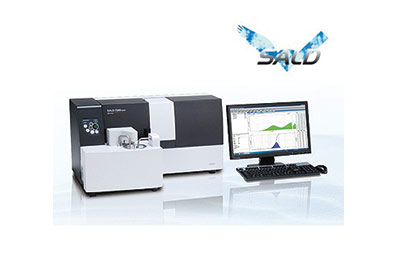SALD-7500nano

The SALD-7500nano is a powerful laser diffraction particle size instrument that has a measurement range of 7 nm to 800 µm. By using a single light source and eliminating the need for laser switching, 1-second measuring intervals can be achieved, effectively allowing for real-time monitoring of particle size. This makes the SALD-7500nano an ideal tool for measuring phenomena such as coalescence and aggregation.

The Scattered Light Intensity Trace (SLIT) optical system, combined with the robust single laser system, allows for high-resolution measurements in the fine particle range. Discontinuities that can arise from the use of multiple lasers are avoided, and reliable data can be obtained using a single measurement principle. Light diffraction of up to a 60° scattering angle can be determined.

The Wing Sensor II, a next-generation iteration of the efficient, gracefully-designed Wing Sensor, provides 78 forward-scattering detector elements to fully capture the range of scattered light. Additionally, five back-scatter detectors and one side-scatter detector are also present, giving a total of 84 detector elements to capture particle sizes spanning up to 6 orders of magnitude in size.

Time-saving sampler unit: SALD-MS75
The SALD-MS75 Sampler Unit reduces cleaning time and improves reproducibility by providing an in-line sonicator and automatic fill, drain, and dilution capabilities. A powerful pump system allows for dense materials to be properly circulated in the solvent. Both PC and manual control of the Sampler Unit are possible to allow for flexibility and customizable control of experiments.


Cost-effective, sample-conserving unit: SALD-BC75 Batch Cell
The SALD-BC75 Batch Cell gives users with limited amounts of sample the ability to still obtain reliable particle size information. The efficient construction of the quartz batch cell allows for volumes as low as 5 cm3 to be measured. The included vertical stirrer prevents sedimentation of the sample keeps particles in the laser path. Additionally, the stirring motion can be used to induce aggregation in certain samples, allowing for real-time monitoring of this phenomenon.

The SALD-HC75 High Concentration Cell is a unique accessory that allows for measurement of pastes, creams, and slurries without dilution. By measuring these samples as-is, accurate information can be obtained about their properties. Under normal circumstances, the measurement of highly concentrated materials results in a phenomenon known as multiple scattering, which provides misleading results. By reducing the path length of these concentrated materials, for example, by placing them in between glass slides instead of a flow cell, multiple scattering can be eliminated and correct results can be obtained.

Shimadzu offers several sample slide designs to allow for known volumes to be deposited. However, standard disposable microscope slides can also be used. This feature means that accurate and reliable data can be obtained on as-is samples in an economical fashion.

Software
WingSALD II is the user-friendly software that is included for all current SALD instruments. Because laser diffraction particle size measurements require input of the refractive index of the sample, the correct values to input may not always be known for new samples. During sample setup, an entry from a database of over 200 materials can be used to obtain a range of refractive indices that best describe the sample. After performing a measurement, the innovative Kinoshita method then automatically provides a series of particle size distributions based on the “best fit” of the light intensity data with the refractive index range. This feature greatly reduces the potential guesswork needed to determine the exact refractive index value of the sample.

When the SALD-7500nano must be used in a demanding quality control operation, the Assist function can be used to ensure complete procedural reproducibility. SOPs can be programmed to ensure that the same process is followed every time. Additionally, administrator rights can be assigned to ensure that only authorized personnel can make modifications or perform non-SOP operations.

For large amounts of data, particularly when samples are measured at 1-second intervals, various visualization schemes in WingSALD II can be used to quickly identify key differences and features. Some of these features include 2D- and 3D-overlay graphs. Additionally, these data can be saved as groups, which allows for easy processing and comparison to other samples.

General Specifications
| Measurement principle | Laser Diffraction Method |
| Measurement range | 7 nm (0.007 μm) to 800 μm (when using sampler) 7 nm (0.007 μm) to 400 μm (when using batch cell) 30 nm (0.03 μm) to 280 μm (when using high-concentration sample unit) |
Note 1: The measurement range varies according to the shape etc. of the particle.
Measurement unit : SALD-7500nano
| Measurement principle | Laser Diffraction Method |
| Light source | Semiconductor laser (Wavelength 405 nm) |
| Light detector | Detector elements for violet semiconductor laser Total 84 elements (78 forward, 1 side, 5 back) |
| System Compliance | Class 1 Laser Product, CE |
| Required power supply | AC 100 V±10%, 1 A, 50/60 Hz |
| Dimensions & weight | Approx. 680 × D280 × H430 mm, Approx.32 kg |
| Operation environment | Temperature : 10 to 30°C , Humidity : 20 to 80% (no condensation) |
Note 2: Reference sample and USB cable (2 m) supplied as standard
Note 3: Ultrasonic cleaning instruments are needed for the measurement of reference sample.
Sampler : SALD-MS75
| Dispersing bath | Capacity : 100 / 200 / 300 mL |
| Sonicator | Frequency : about32 kHz, output : about 40 W |
| Liquid pump | Radial pump, maximum flow rate 2000 cm3/min |
| Liquid pump material | Stainless (SUS 304, SUS 316), Tetrafluoroethylene (PTFE), Perfluoroelastmor (FEP) |
| Liquid supply pump | Diaphragm pump, maximum flow rate : 750cm3/min |
| Liquid supply pump material | Polypropylene |
| Flow cell | Quartz glass |
| Required power supply | AC 100 V±10%, 2 A, 50/60 Hz |
| Dimensions & weight | Approx. W390 × D520 × H430 mm, Approx.18 kg |
| Operating environment | Temperature: 10 to 30°C, Humidity: 20 to 80% (no condensation) |
Note 4: USB cable (2 m) supplied as standard
Batch Cell : SALD-BC75
| Cell material | Quartz glass |
| Required liquid volume | Approx. 5 cm3 |
| Stirrer mechanism | Up-and-down movement of blade |
| Dimensions & weight | Approx. W100 × D120 × H140 mm, Approx. 0.8 kg |
| Operating environment | Temperature: 10 to 30°C, Humidity: 20 to 80% (no condensation) |
High-concentration Sample Measurement System : SALD-HC75
| Cell material | Borosilicate glass |
| Required liquid volume | Approx. 0.15 cm3 |
| Dimensions & weight | Approx. W20 × D100 × H9 mm, Approx. 0.2 kg |
| Operating environment | Temperature: 10 to 30°C, Humidity: 20 to 80% (no condensation) |
Software Specifications
(WingSALD II)
| Measurement and Data Display Functions | |
|---|---|
| Measurement of Particle Size Distribution | Allows measurements using measurement assistant function (interactive process based on SOP) |
| Refractive Index Setting | Automatic refractive index calculation function (LDR method: Light Intensity Distribution Reproduction Method) makes setting the refractive index easy. |
| Real-Time Display | Particle size distribution/light intensity distribution simultaneous display |
| Diagnostics/Adjustments | Self-diagnostic function and cell check function |
| Recalculation of Particle Size Distribution | Batch recalculation of max. 200 distributions |
| Display of Particle Size Distribution Data | Displays overlay of max. 200 distributions |
| Display of Light Intensity Distribution | Displays overlay of max. 200 distributions |
| Statistical Data Processing | Max. 200 sets of data (also allows overlaying max. 200 data sets) |
| Time-Series Processing | Max. 200 sets of data |
| 3-Dimensional Graphing | Max. 200 sets of data |
| Data Transfer via Clipboard | [Image Output]: Outputs entire data sheet or graph only. [Text Output]: Outputs summary data, particle size distribution data, or light intensity distribution data. |
| Data Sorting | Sorts by file name, sample ID, sample number, or refractive index |
| Output Conditions | |
| Particle Size (μm) Divisions | Fixed 51 or 101 divisions : User settable 51 divisions |
| Particle Amount (%) Divisions | Fixed 51 divisions : User settable 51 divisions |
| Distribution Basis | Count, length, area, or volume |
| Expression of Cumulative Distribution | Oversized or undersized |
| Expression of Frequency Distribution | q, q / Δ×, q / Δlog × |
| Smoothing Levels | 10 levels |
| Distribution Function Fitting | Rosin-Rammler distribution, logarithmic Gaussian distribution |
| Data Shifting | ±10 levels |
| Report Function | Single data sets (6 templates), overlaid data (5 templates), statistical data, time-series data, or 3D data can be selected and output using batch processing |
| Data Analysis Functions | |
| Scattering Angle Evaluation Function | Evaluates scattering characteristics within micro angle regions for samples such as optical films and sheets. |
| Data Emulation Functions | Emulates measurement results from other instruments and measurement principles, using SALD series measurement results. |
| Mixture Data Simulation Function | Simulates particle size distributions using any mixture ratio of multiple particle size distributions. |
| Data Connection Function | Combines two particle size distributions with different measurement ranges at any particle size point to create a single particle size distribution. |
| Continuous Measurement Function | Continuously measures changes in particle size distributions and particle diameters over time, at intervals as short as one second, and saves the results. |
Note 5: The LDR method automatically calculates an appropriate refractive index based on consistency between the actual measured light intensity distribution and one reproduced (recalculated) from particle size distribution data. This method was developed by Shimadzu and published in two technical papers. It is sometimes called the "Kinoshita Method", in academic communities, after the name of Shimadzu's engineer.
